
Orange Tree tapestry
I checked out a bunch of books from the library and lined up a number of projects. The first one I completed was from Exquisite Miniatures in Cross Stitch and Other Counted Thread Techniques by Brenda Keyes. This book is not specifically for dollhouses but has smaller real life size projects that can be used in miniature settings both with and without minor modifications.
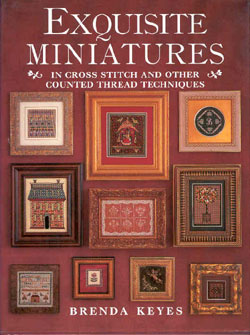
The art is called Orange Tree, so I thought it would look nice in a conservatory.
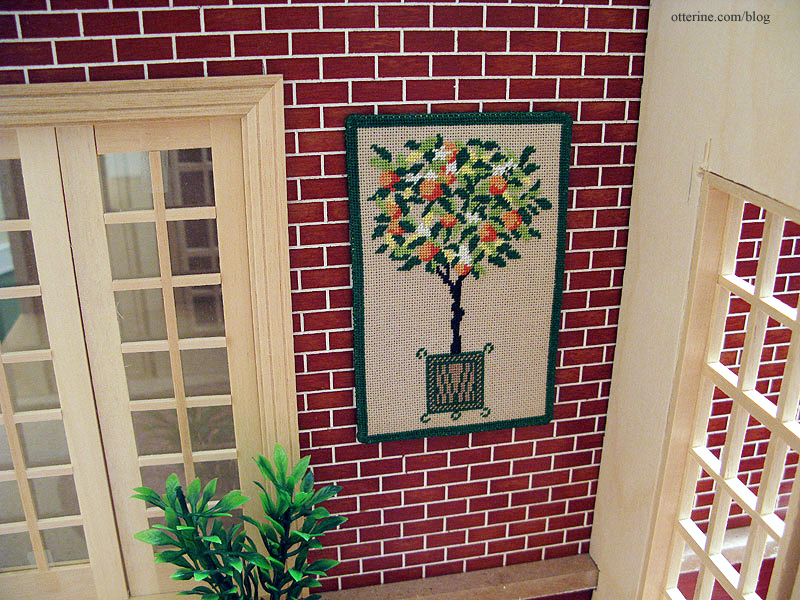
I stitched it on 28 count evenweave fabric in mushroom color. The book had called for it to be stitched on 22 count needlepoint canvas. The color of the fabric saved my having to stitch the background, and the higher count made the project smaller in size. The needlework is mounted on stiff felt on the back.
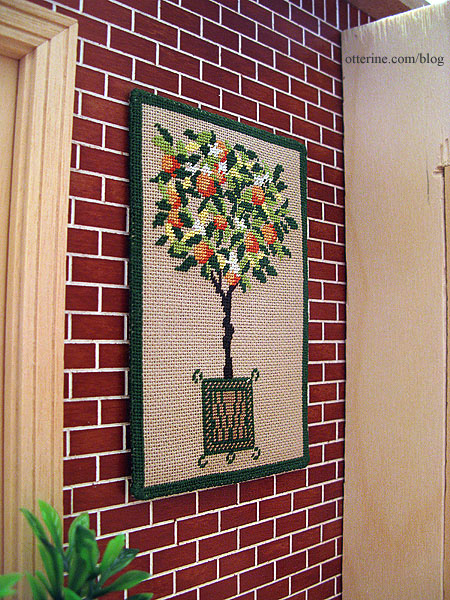
Categories: Needlework - French knot rugs
March 7, 2010 | 0 commentsNewport – Conservatory
Though the Newport was sold eventually, I’ve compiled some of the posts I made when I first started building it.
—-
The conservatory sits above the garage and is accessible from the master bedroom. The double French doors came from the Foxhall Conservatory kit used to create the garage.
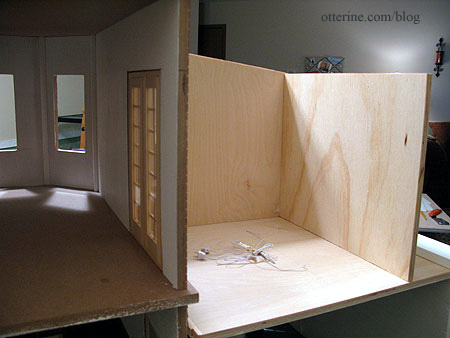
The stairs from the master bedroom are the original front door steps for the Newport kit. I will leave the brick wall exposed, but I haven’t decided on an exterior or interior finish for the conservatory walls. The windows will obviously take up most of the surface area.
Before cutting the French door and window openings in the new conservatory walls, I did a little planning to figure out how the furniture would fit best. The plaid sofa and chair shown below now reside in the study, but they’re about the same size as what I have planned for this space.
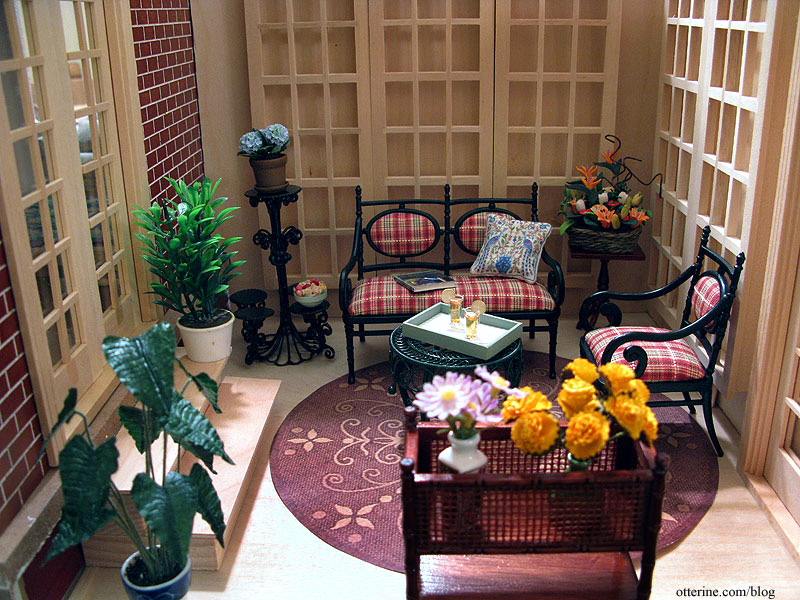
I made the elephant ear plant from floral tape and wire. The rattan planter is by Concord Miniatures. I’ll have more plants, most of which I plan to make myself, including some hanging plants. It looks a bit crowded from the perspective shown in the photo above, but the room is actually spacious. The rug is a paper printout of the Piazza rug in brown by Dynamic Rugs, but I plan to recreate it in another material besides paper, such as punchneedle or needlepoint.
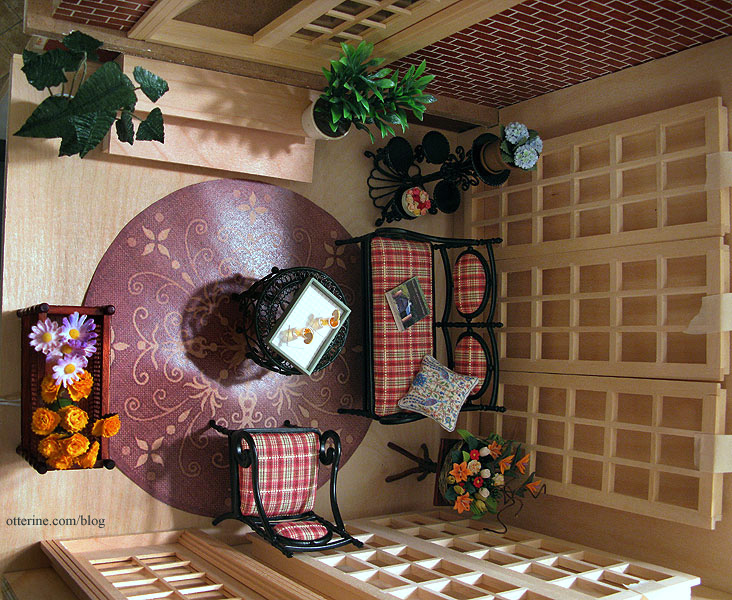
I cut the window and door openings in the new 3/8″ plywood walls. The foam core rooftop is just for planning purposes. I haven’t decided on whether I want a glass (i.e., acrylic sheet) roof or a solid one. The single French door opens to allow access to the outside of the conservatory where there will be a narrow walkway and room for outdoor plants.
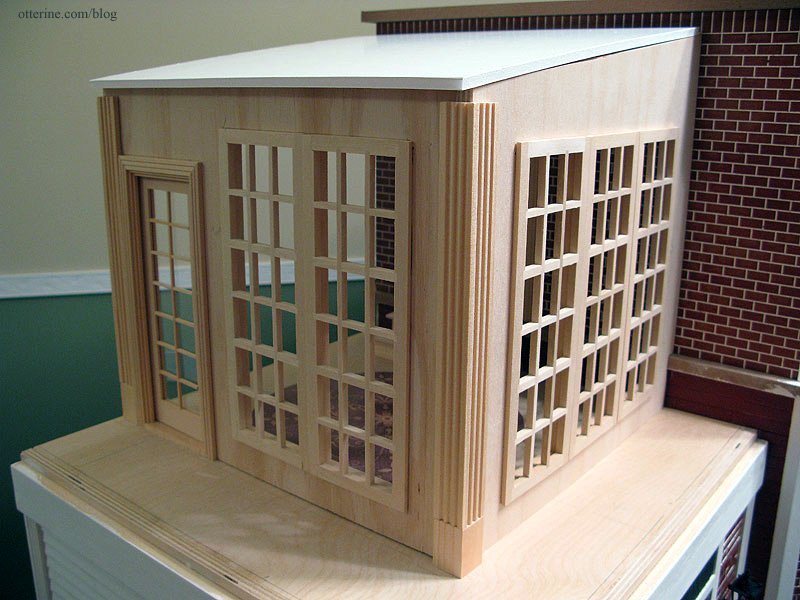
I’m rather excited about this room, mainly because it is turning out as I had hoped just like the garage. Both the conservatory and the garage are partial scratch built rooms using the Foxhall Conservatory kit as the basis.
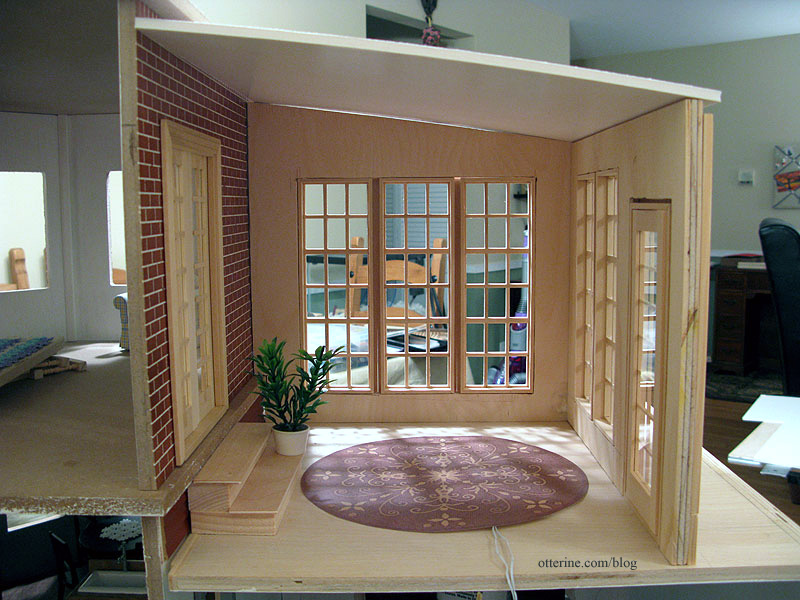
Categories: The Newport
March 2, 2010 | 0 commentsMackintosh chair covers
I’ve been checking out books from the library to find ideas for projects and to generally drool over all of the beautiful minis out there. One of the better books I found was Embroidered Projects by Sue Hawkins.
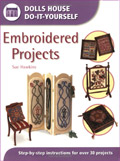
It has rugs, screens and pillows in a nice array of styles. There were a few lovely items worth spending the time stitching, but there was one in particular that caught my eye: the Mackintosh chair cover. I already had the chairs…and the design in the book fit perfectly with my modern living room.
In the past, I’ve done quite a bit of counted cross-stitch but very little needlepoint. The project called for 32-count silk gauze but I had a hard time locating it. I also changed the colors from what was listed in the book because the pinks were just too bright for my taste.
My eyesight has always been good, but wow were these tiny stitches!
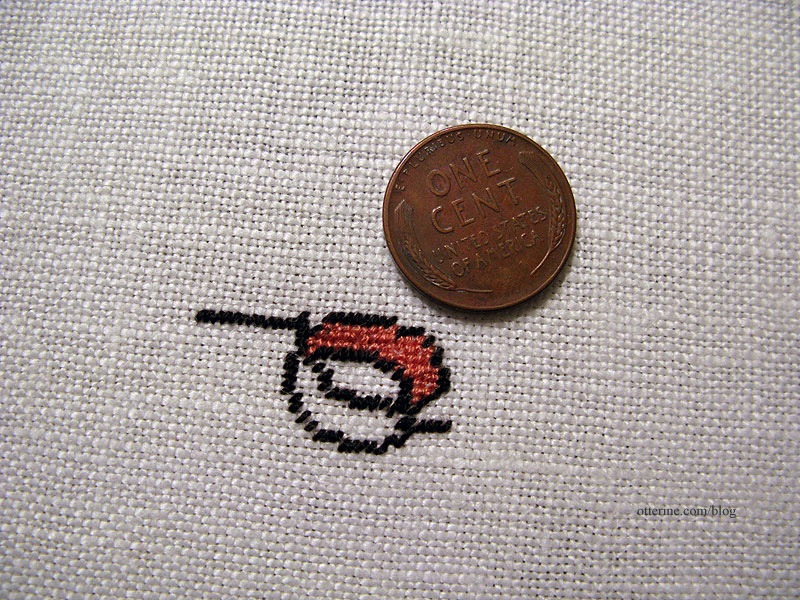
The first one took a little over five and a half hours of work, and I did it without the aid of a magnifier. For the second one, I flipped the design to have a mirror of the first and bought a magnifier with two LEDs. The second one (at the bottom of the photo below) took about the same amount of time but it was much cleaner since I could actually see what I was doing. :D Since I already had enough fabric in the hoop, I decided to make another like the first one; it turned out much better the second time around.
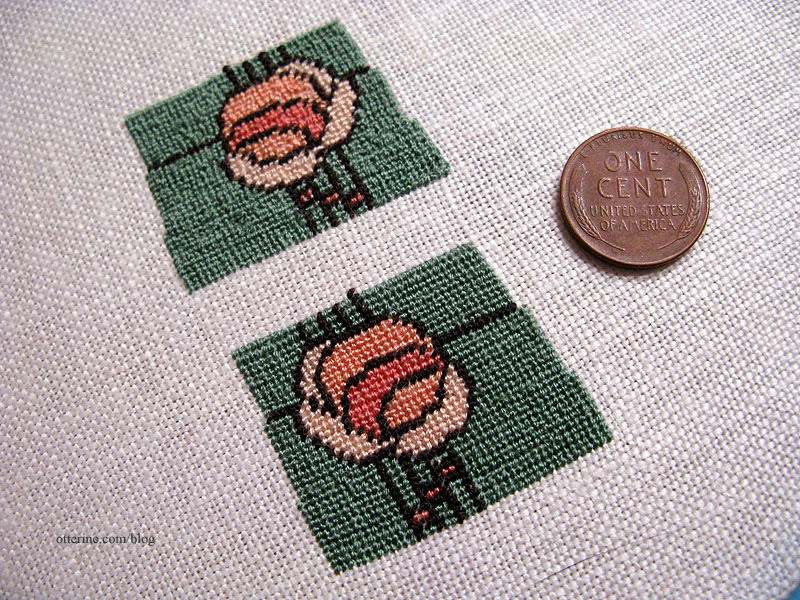
I had to remove the glued-on chair pads, which was a scary task since the chairs were expensive. I popped them into the microwave to loosen the glue, but it still wasn’t easy removing them. While the cushions were off, I gave the chairs a couple of coats of Bittersweet Chocolate paint by Americana. The original finish was uneven and a bit too red. I then sealed them with satin varnish.
I removed the original fabric from the chair pads and used the needlework to upholster the chairs. I finished the edges with twisted embroidery floss. I think they turned out pretty well for my first attempt at miniature needlework and fit in rather well with the modern style and colors in the living room.
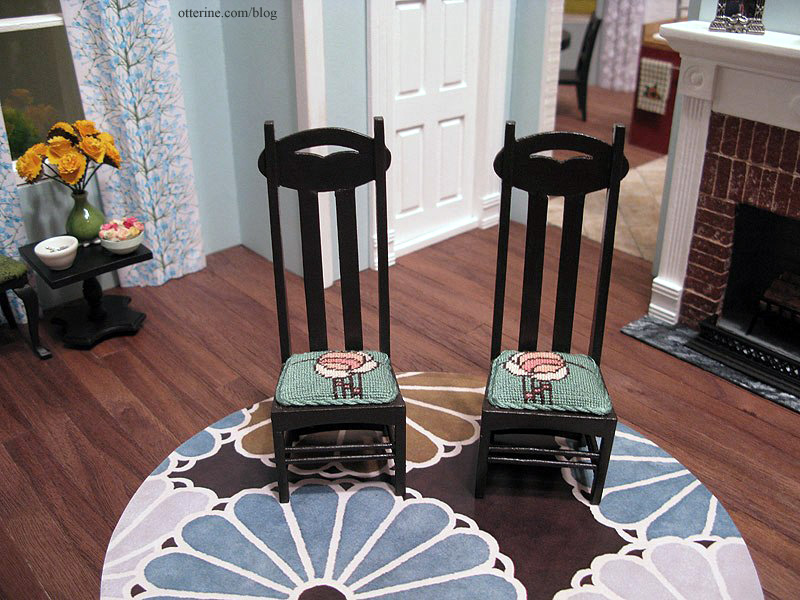
Categories: Needlework - French knot rugs
February 24, 2010 | 0 commentsDivan and tray
I had no idea what a divan was, but when I saw one in Dolls’ House Furniture: Easy-to-make projects in 1/12 scale by Freida Gray I knew I had to have one. :D

I used the instructions in the book as a starting point but ended up making my divan a different size and height. I also changed the way it was put together compared to the book’s construction.
I eyeballed the size I wanted and cut the top and base from 1/2″ balsa. I added a frame of 1/4″ balsa to the base to make it thicker.

I used 1/2″ wood blocks for the feet, painting them Bittersweet Chocolate by Americana.

I hemmed a strip of fabric and wrapped it around the base, leaving just a tiny bit of the legs exposed.

This project was made much easier by using Peel-n-Stick Fabric Fuse. It’s an adhesive on a paper backing that you stick on, peel away the backing to expose the other side of the adhesive and then press in place. It comes in different widths; I bought a 5/8″ wide roll. I tacked the excess fabric on top of the base with tacky glue and set it aside.
I put a thin layer of batting on the top piece.

I have a vintage Tot 50 stapler by Swingline, and this is the first time I’ve used it in years. :] It made it very easy to upholster the top and get a taught surface over the batting.

I glued the top to the base with tacky glue and set the assembly aside.
In order to create the band to cover the seam between the top and bottom pieces, I used a strip of crinoline covered by fabric. Crinoline is a stiff fabric that makes it very easy to get a crisp band of fabric with no wrinkles.

I used the Peel-n-Stick fabric fuse to attach the band. There is a seam for both the bottom fabric and the band, but you would have that on a real life upholstered piece as well.

I love it! It now serves as the coffee table for the study.
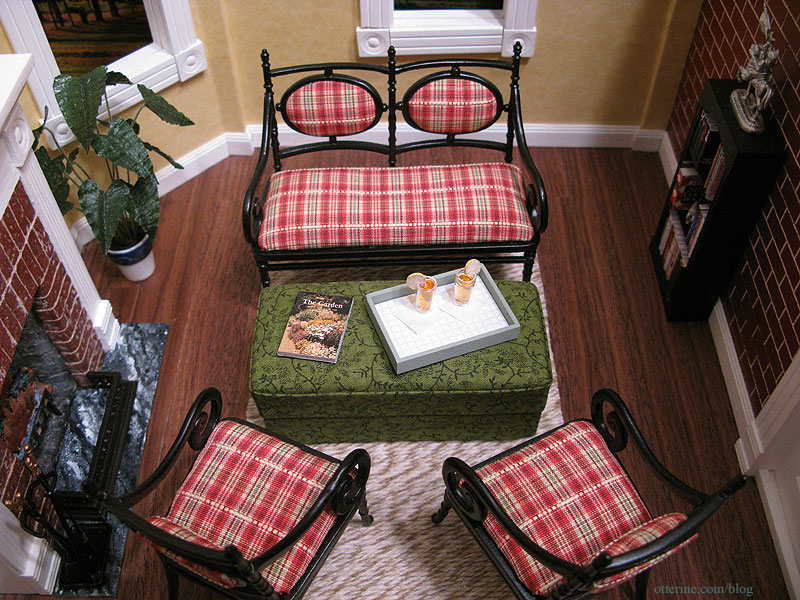
The green of the divan fabric brings out the green in the Bespaq plaid furniture in the room.

The tray is a replica inspired by the shabby chic trays made by Pei Li, an artisan who makes some absolutely beautiful 1:12 scale miniatures.
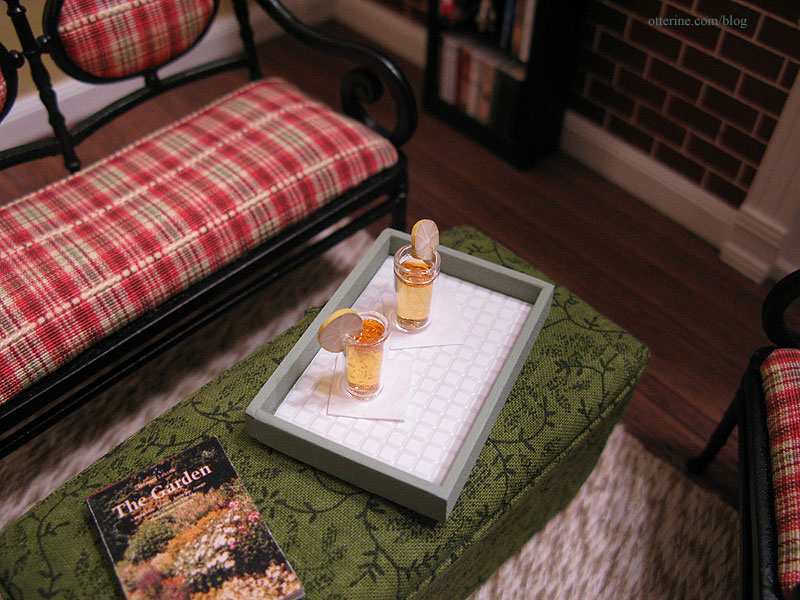
Categories: Furniture
February 15, 2010 | 0 commentsScratch built sofa
I borrowed Dollhouse Magic by P. K. Roche from the library, and it turned out to be a rather simplistic book of miniature making, such as using thread spools for tables. But, the instructions on using kitchen sponges to make sofas and chairs inspired an idea. I wanted the living room to be more modern, and I thought using sponges would be a great way to achieve the shape a modern sofa. It would be easier than trying to cut and shape pieces of wood while still being firm enough for structure. I could add thin pieces of wood where I needed extra support and then upholster the piece with batting and fabric.
After scouring (er…nevermind) the internet for ideas, I decided to go with the Dream Velvet Sofa by Graham & Green, a home furnishing company in the UK.
I bought cellulose sponges in different shapes and sizes at Target. I had to leave them out on the counter for a few days to let them dry out. In the process of drying, they shrank a bit so I was glad I hadn’t used right them out of the package.

Using the overall real life dimensions as a guide, I started cutting the sponges into thinner pieces. I used the curved sponge to make the arms of the sofa, cutting it into thinner sections using a serrated kitchen knife. It was rather like cutting really stale bread. :D

I used a large sponge for the base of the sofa. It had dried to an uneven thickness, so I marked all four sides with a sharpie and used the knife to shave off the excess and shape the base.

Below is my initial basic sponge structure. The cushions are cut small to leave room for batting and fabric. I’ve used some wooden beads to mockup the legs, but I’ll shape some legs from wood during the finishing process.

The back cushions on the original sofa were taller than the back, so I think my side angle is a bit steep. I’ll have to cut that down before upholstering. The coffee table here is just a placeholder; it’s a bit traditional for this modern room.

For the upholstery, I chose chocolate brown micro suede. I’ve been sewing for a long time, but this was my first time upholstering…mini or otherwise. It took me quite some time to figure out the best way to get the fabric on the sponge and wood frame. I sewed some, glued some…swore some. :]
I used batting to smooth out the front edge of the base and the seat cushions. I glued a thin sheet of balsa wood to the back to have a smooth surface under the upholstery. Here it is in mid-assembly.

Here it is mostly complete. I need to tweak the fit of the cushions and adjust the legs, but overall I like the way it turned out. :]
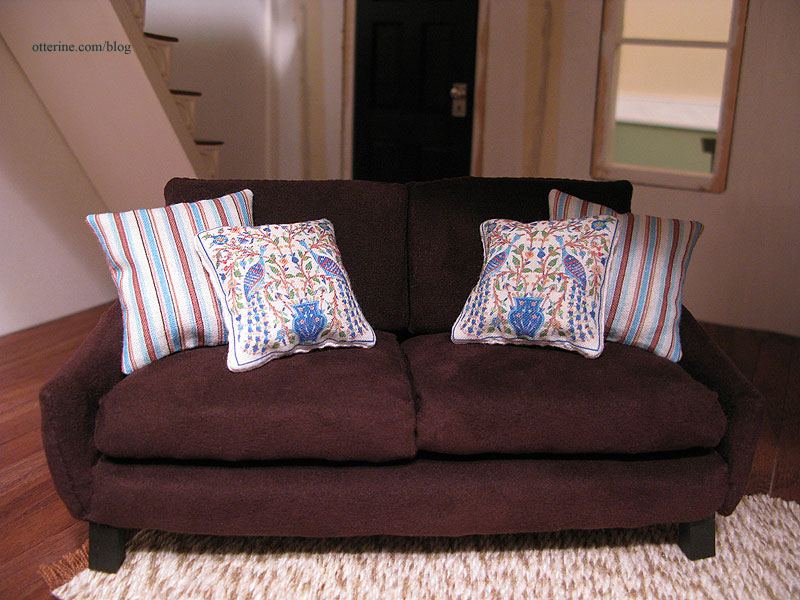
The striped pillows were created by finding designs online, resizing in PhotoShop and printing on fabric. The bird pillows are actually made from a resized image of tiles by Jerusalem Pottery, which I then printed on fabric.
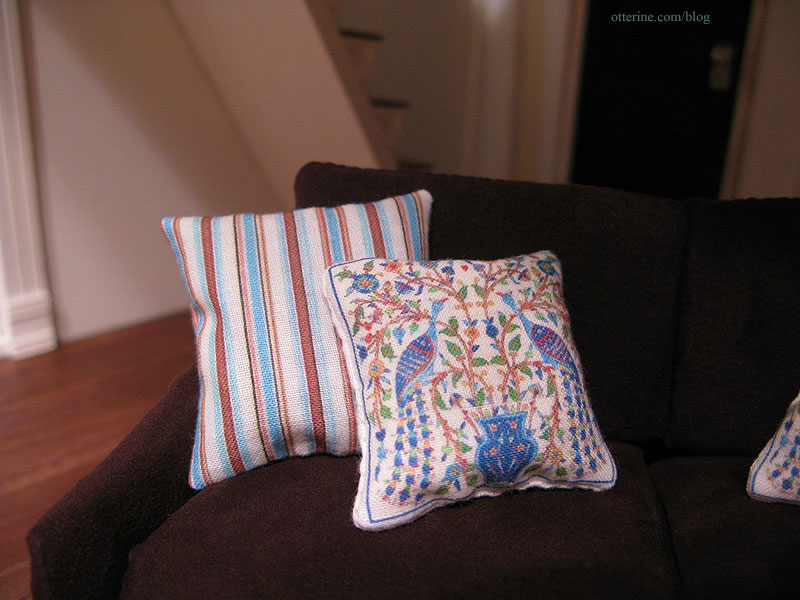
Filling the pillows with beads gave them some weight and made it easier to shape them.
Categories: Furniture
February 12, 2010 | 0 comments
NOTE: All content on otterine.com is copyrighted and may not be reproduced in part or in whole. It takes a lot of time and effort to write and photograph for my blog. Please ask permission before reproducing any of my content. Please click for copyright notice and Pinterest use.






































